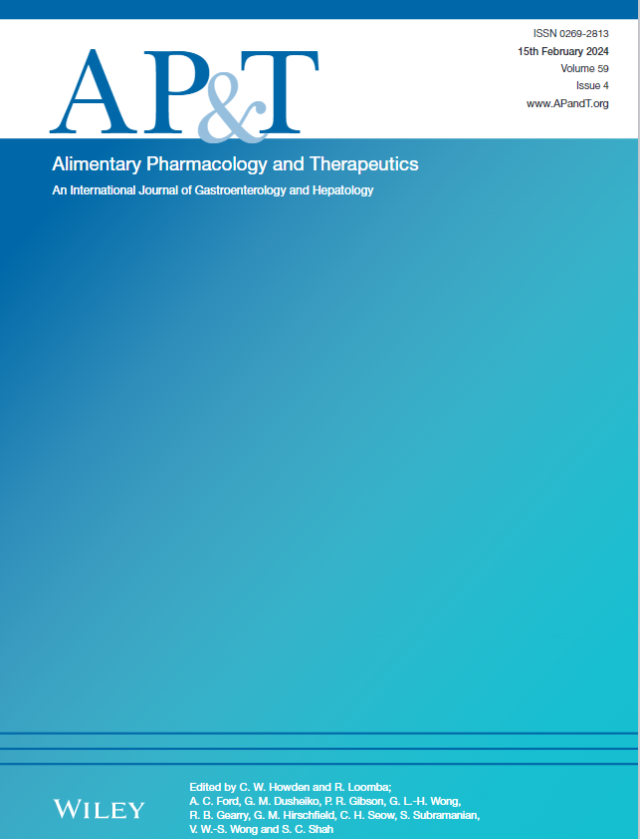在一项前瞻性研究中,对NA停药患者的长期随访确定了不同类型的HBsAg损失
IF 6.7
1区 医学
Q1 GASTROENTEROLOGY & HEPATOLOGY
引用次数: 0
摘要
背景和目的在某些慢性乙型肝炎(CHB)患者中,停用核苷类似物(NAs)可能导致功能性治愈(HBsAg丢失)。我们在一个前瞻性队列中评估了长期随访期间HBsAg损失率和预测因素。方法:这项现实世界的扩展研究跟踪了NA停药前瞻性试验的参与者。所有患者均为HBeAg阴性CHB,无肝硬化。评估了疗效结局(包括HBsAg损失和下降)和安全性结局(包括肝炎爆发和肝细胞癌(HCC))。结果在97名参与者中(85%为亚洲人),中位随访时间为7年,在停用NA后5年、7年和9年,HBsAg损失的累积发生率分别为10%、13%和22%。HBsAg损失与治疗末期(EOT) HBsAg水平(HR = 0.28, p < 0.001)、年龄(HR = 1.14, p = 0.005)和治疗结束后HBV DNA峰值水平(OR = 0.50, p = 0.002)相关。EOT HBsAg水平≤10 IU/mL的参与者在没有ALT耀斑的情况下经历了早期HBsAg损失(96周),而那些EOT HBsAg水平≥10 IU/mL的参与者经历了晚期(≥96周)HBsAg损失,通常是在ALT耀斑之后(5/8例)。无肝失代偿、肝移植及死亡病例发生。中位肝硬度未增加。3人被诊断为HCC(4.4/1000人-年)。结论功能治愈率在长期随访中有所提高,但仍处于较低水平。EOT对HBsAg损失的可能性和时间有很强的预测作用。ALT耀斑与HBsAg下降有关,在某些情况下,与延迟的HBsAg损失有关。试验注册:临床研究由国家卫生与医学研究委员会支持,研究临床试验ID为NCT02581033本文章由计算机程序翻译,如有差异,请以英文原文为准。
Long‐Term Follow‐Up of Patients in a Prospective Study of NA Discontinuation Identifies Different Patterns of HBsAg Loss
Background and AimsDiscontinuing nucleos(t)ide analogues (NAs) may lead to functional cure (HBsAg loss) in selected patients with chronic hepatitis B (CHB). We evaluated the rates and predictors of HBsAg loss during long‐term follow‐up in a prospective cohort.MethodsThis real‐world extension study followed participants from a prospective trial of NA discontinuation. All patients had HBeAg‐negative CHB without cirrhosis. Efficacy outcomes (including HBsAg loss and decline) and safety outcomes [including hepatitis flare and hepatocellular carcinoma (HCC)] were evaluated.ResultsAmongst 97 participants (85% Asian), with a median follow‐up of 7 years, the cumulative incidence of HBsAg loss was 10%, 13% and 22% at 5, 7 and 9 years after stopping NA. HBsAg loss was associated with a lower end‐of‐treatment (EOT) HBsAg level (HR = 0.28, p < 0.001), older age (HR = 1.14, p = 0.005) and peak off‐treatment HBV DNA level (OR = 0.50, p = 0.002). Participants with EOT HBsAg level ≤ 10 IU/mL experienced early HBsAg loss (< 96 weeks) without ALT flares whilst those with EOT HBsAg level ≥ 10 IU/mL experienced late (≥ 96 weeks) HBsAg loss, often following ALT flares (5/8 cases). No cases of hepatic decompensation, liver transplantation or death occurred. Median liver stiffness did not increase. HCC was diagnosed in three individuals (4.4/1000 person‐years).ConclusionThe rate of functional cure increased during long‐term follow‐up but remained low. EOT HBsAg strongly predicted the likelihood and timing of HBsAg loss. ALT flares were associated with HBsAg decline, and in some cases, with delayed HBsAg loss.Trial Registration: The clinical study was supported by the National Health and Medical Research Council of the study clinical trial ID is NCT02581033
求助全文
通过发布文献求助,成功后即可免费获取论文全文。
去求助
来源期刊
CiteScore
15.60
自引率
7.90%
发文量
527
审稿时长
3-6 weeks
期刊介绍:
Alimentary Pharmacology & Therapeutics is a global pharmacology journal focused on the impact of drugs on the human gastrointestinal and hepato-biliary systems. It covers a diverse range of topics, often with immediate clinical relevance to its readership.

 求助内容:
求助内容: 应助结果提醒方式:
应助结果提醒方式:


